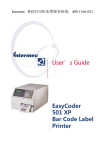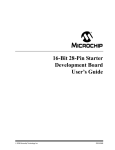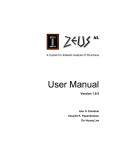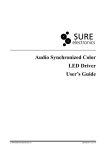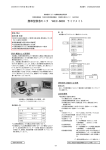Download EDP-CM-PIC-PIM User Manual
Transcript
EDP-CM-PIM Adapter Board dsPIC/PIC ‘Command Module’ – Adapter Board EDP-CM-PIC-PIM User Manual Version 1.04 10th June 2010 Electrocomponents plc Page 1 EDP-CM-PIM Adapter Board Contents 1. Introduction 2. 2.1 2.2 2.3 2.4 2.5 MCU Mapping 3 MCU Pin Allocation ......................................................................... 3 Backplane Resources Used by the MCU ........................................ 5 Alphabetical Listing of MCU Pins .................................................... 7 Backplane Signal Names and Connections .................................... 9 Mapping Aids ................................................................................ 12 3. Jumper Options 13 4. Zero Ohm Links 19 5. 5.1 Software Support 22 dsPIC33FJ256MC710 ................................................................... 22 Electrocomponents plc 3 Page 2 EDP-CM-PIM Adapter Board 1. Introduction The RS-EDP platform is a system, which has been designed to utilise many different manufacturers’ microprocessors. To support Microchip’s family of devices, the RS-EDP platform uses an adapter board to connect between the RS-EDP baseboard and the Microchip PIM modules. This is referred to as the EDP-CM-PIM module. Microchip have most of their MCU’s available, pre-mounted on 80 pin and 100 pin PIM modules. These are square in shape and use pin headers to connect down to a daughter board, which in the Microchip system is usually some form of evaluation board. The RS-EDP therefore uses these modules with an adapter board to gain access to the Microchip portfolio of devices. One adapter board can be used with pretty much all of the Microchip PIM modules, from the 8 bit PIC16Cxx family, through to the 16bit dsPIC family and the new 32bit PIC32 family. The PIM modules are available to order directly from the RS website, and are separately listed in the catalogue from the RS-EDP platform. The adapter board is configured as a ‘Command Module’. The ‘Command Module’ in a system dictates whether the whole system is a 3.3V one or a 5.0V one. The module has a link option which decides which of the two voltages is used within the system. The Vcc_CM line is set to this level by the link option on this adapter module. This Vcc_CM is used as a reference by the other modules, such as the analogue module for example. The daughter board remaps the I/O of the PIM module on to the backplane of the RS-EDP system. As the RS-EDP system has a similar concept to the PIM module system from Microchip, you will find most of the PIM modules will correctly map out to the RS-EDP backplane. During the development of this board, several devices were chosen for trial fits to the RS-EDP system. These included the dsPIC33FJ256MC710, the dsPIC33FJ256GP710 and the PIC32Mx4xxFxxxL devices. 2. MCU Mapping 2.1 MCU Pin Allocation The MCU pins have been allocated to the backplane as follows dsPIC33FJ256MC710 Pin 1 2 3 4 5 6 7 8 9 10 11 12 13 14 Electrocomponents plc Name Comment 2 link options 2 link options RG15 Vdd PWM3H/RE5 PWM4L/RE6 PWM4H/RE7 AN16/T2CK/T7CK/RC1 AN17/T3CK/T6CK/RC2 AN18/T4CK/T9CK/RC3 AN19/T5CK/T8CK/RC4 SCK2/CN8/RG6 SDI2/CN9/RG7 SDO2/CN10/RG8 #MCLR #SS2/CN11/RG9 Page 3 RS-EDP-BASE BOARD Name GPIO5_I2S_TX_WS GPIO9_I2S_RX_WS 3.3V MOTORP2H AN8 AN9 GPIO2_MCI_DAT0 GPIO4_MCI_DAT1 GPIO6_MCI_DAT2 GPIO8_MCI_DAT3 SPI_SSC_CLK SPI_SSC_MTSR_MOSI SPI_SSC_MRST_MISO #RESIN SPI_SSC_#CS_NSS EDP-CM-PIM Adapter Board 15 16 17 18 19 20 21 22 23 24 Vss Vdd TMS/RA0 AN20/#FLTA/INT1/RE8 AN21/#FLTB/INT2/RE9 AN5/QEB/CN7/RB5 AN4/QEA/CN6/RB4 AN3/INDX/CN5/RB3 AN2/#SS1/CN4/RB2 PGC3/EMUC3/AN1/CN3/RB1 25 PGD3/EMUD3/AN0/CN2/RB0 26 PGC1/EMUC1/AN6/OCFA/RB6 27 PGD1/EMUD1/AN7/RB7 28 29 30 31 32 33 34 35 36 37 38 39 40 41 42 43 44 45 46 47 48 49 50 Vref-/RA9 Vref+/RA10 Avdd Avss AN8/RB8 AN9/RB9 AN10/RB10 AN11/RB11 Vss Vdd TCK/RA1 #U2RTS/RF13 #U2CTS/RF12 AN12/RB12 AN13/RB13 AN14/RB14 AN15/OCFB/CN12/RB15 Vss Vdd IC7/#U1CTS/CN20/RD14 IC8/#U1RTS/CN21/RD15 U2RX/CN17/RF4 U2TX/CN18/RF5 SGND 3.3V GPIO10_MCI_CLK AN2 AN3 MOTORH0_ENC0 MOTORH1_ENC1 MOTORH2_ENC2 CNTRL_SPI_#CS_NSS AN4 Local EMUC AN5 Local EMUD GPIO33_AD11 Local EMUC GPIO34_AD2 Local EMUD GPIO14_MCI_PWR GPIO12_MCI_CMD AN_REF VAGND AN6 AN7 AN0 AN1 SGND 3.3V GPIO24_AD7 GPIO25_AD15 GPIO26_AD6 GPIO27_AD14 GPIO28_AD5 GPIO29_AD13 GPIO30_AD4 SGND 3.3V EVM10_GPIO68_ASCO_CTS EVG20_GPIO69_ASCO_RTS ASC1_RX_TTL ASC1_TX_TTL 51 52 53 54 55 56 57 58 59 60 61 62 63 64 65 66 67 68 69 70 U1TX/RF3 U1RX/RF2 SDO1/RF8 SDI1/RF7 SCK1/INT0/RF6 SDA/RG3 SCL1/RG2 SCL2/RA2 SDA2/RA3 TDI/RA4 TDO/RA5 Vdd OSC1/CLKIN/RC12 OSC2/CLKO/RC15 Vss INT3/RA14 INT4/RA15 IC1/RD8 IC2/RD9 IC3/RD10 ASC0_TX_TTL ASC0_RX_TTL CNTRL_SPI_MRST CNTRL_SPI_MTSR CNTRL_SPI_CLK CNTRL_I2C_SDA CNTRL_I2C_SCL I2CGEN1_SCL I2CGEN1_SDA EVG7_GPIO54 EVG8_GPIO56 3.3V Not applicable Not applicable SGND EMG_TRAP EVM6_GPIO49 EVM7_GPIO51 MOTOR_TCO_FB EVM8_GPIO53 Electrocomponents plc 2 link options 2 link options 2 link options 2 link options 2 link options 2 link options 2 link options 2 link options Page 4 EDP-CM-PIM Adapter Board 71 72 73 IC4/RD11 OC1/RD0 PGD2/EMUD2/SOSCI/CN/RC13 74 PGC2/EMUC2/SOSCO/T1CK/CN0/RC14 75 Vss 76 77 78 79 80 81 82 83 84 85 86 87 OC2/RD1 OC3/RD2 OC4/RD3 IC5/RD12 IC6/CN19/RD13 OC5/CN13/RD4 OC6/CN14/RD5 OC7/CN15/RD6 OC8/UPDN/CN16/RD7 Vddcore Vdd C1RX/RF0 88 C1TX/RF1 89 C2TX/RG1 90 C2RX/RG0 91 92 93 94 95 AN22/CN22/RA6 AN23/CN23/RA7 PWM1L/RE0 PWM1H/RE1 RG14 96 97 98 99 100 RG12 RG13 PWM2L/RE2 PWM2H/RE3 PWM3L/RE4 2 link options 2 link options 2 link options 2 link options EVM9_GPIO55 MOTORPWM GPIO0 local 32kHz sub clock GPIO1 local 32kHz sub clock SGND 2 link options 2 link options 2 link options 2 link options 3 link options 3 link options 3 link options EVG0_GPIO40 EVG1_GPIO42 EVG2_GPIO44 EVM2_GPIO41_CAPADC EVM3_GPIO43 EVG3_GPIO46 EVG4_GPIO48 EVG5_GPIO50 EVG6_GPIO52 Not applicable 3.3V CAN0_RX GPIO35_AD10 CAN0_TX GPIO36_AD1 GPIO31_ADI2 USB_HOST_DUSB_DEV_D- 3 link options GPIO32_AD3 3 link options 3 link options USB_HOST_D+ USB_DEV_D+ EVM4_GPIO45 EVM5_GPIO47 MOTORP0L MOTORP0H GPIO13_I2S_TX_CLK GPIO7_I2S_RX_CLK GPIO11_I2S_RX_SDA GPIO15_I2S_TX_SDA MOTORP1L MOTORP1H MOTORP2L 2 link options 2 link options 2.2 Backplane Resources Used by the MCU Resources used/available 3.3V Vcc_CM AN_REF #RESIN SGND VAGND AN0 AN1 AN2 AN3 AN4 AN5 AN6 AN7 AN8 AN9 Electrocomponents plc Page 5 EDP-CM-PIM Adapter Board ASC0_RX_TTL ASC0_TX_TTL ASC1_RX_TTL ASC1_TX_TTL CAN0_RX CAN0_TX CNTRL_I2C_SCL CNTRL_I2C_SDA I2CGEN1_SCL I2CGEN1_SDA CNTRL_SPI_#CS_NSS CNTRL_SPI_CLK CNTRL_SPI_MTSR CNTRL_SPI_MRST SPI_SSC_#CS_NSS SPI_SSC_CLK SPI_SSC_MTSR_MOSI SPI_SSC_MRST_MISO EVG0_GPIO40 EVG1_GPIO42 EVG2_GPIO44 EVG3_GPIO46 EVG4_GPIO48 EVG5_GPIO50 EVG6_GPIO52 EVG7_GPIO54 EVG8_GPIO56 EVG20_GPIO69_ASCO_RTS EVM2_GPIO41_CAPADC EVM3_GPIO43 EVM4_GPIO45 EVM5_GPIO47 EVM6_GPIO49 EVM7_GPIO51 EVM8_GPIO53 EVM9_GPIO55 EVM10_GPIO68_ASCO_CTS GPIO0 GPIO1 GPIO5_I2S_TX_WS GPIO7_I2S_RX_CLK GPIO9_I2S_RX_WS GPIO11_I2S_RX_SDA GPIO13_I2S_TX_CLK GPIO15_I2S_TX_SDA GPIO24_AD7 GPIO25_AD15 GPIO26_AD6 GPIO27_AD14 GPIO28_AD5 GPIO29_AD13 GPIO30_AD4 GPIO31_ADI2 GPIO32_AD3 GPIO33_AD11 GPIO34_AD2 GPIO35_AD10 GPIO36_AD1 GPIO10_MCI_CLK GPIO12_MCI_CMD GPIO14_MCI_PWR Electrocomponents plc Page 6 EDP-CM-PIM Adapter Board GPIO2_MCI_DAT0 GPIO4_MCI_DAT1 GPIO6_MCI_DAT2 GPIO8_MCI_DAT3 MOTORP0H MOTORP0L MOTORP1H MOTORP1L MOTORP2H MOTORP2L MOTORH0_ENC0 MOTORH1_ENC1 MOTORH2_ENC2 MOTORPWM EMG_TRAP MOTOR_TCO_FB USB_HOST_D+ USB_HOST_DUSB_DEV_D+ USB_DEV_D- 2.3 Alphabetical Listing of MCU Pins Pin 13 14 40 39 23 22 21 20 32 33 34 35 41 42 43 44 6 7 8 9 18 19 91 92 30 31 87 88 90 89 68 69 70 71 79 Alphabetical Pin Function #MCLR #SS2/CN11/RG9 #U2CTS/RF12 #U2RTS/RF13 AN2/#SS1/CN4/RB2 AN3/INDX/CN5/RB3 AN4/QEA/CN6/RB4 AN5/QEB/CN7/RB5 AN8/RB8 AN9/RB9 AN10/RB10 AN11/RB11 AN12/RB12 AN13/RB13 AN14/RB14 AN15/OCFB/CN12/RB15 AN16/T2CK/T7CK/RC1 AN17/T3CK/T6CK/RC2 AN18/T4CK/T9CK/RC3 AN19/T5CK/T8CK/RC4 AN20/#FLTA/INT1/RE8 AN21/#FLTB/INT2/RE9 AN22/CN22/RA6 AN23/CN23/RA7 Avdd Avss C1RX/RF0 C1TX/RF1 C2RX/RG0 C2TX/RG1 IC1/RD8 IC2/RD9 IC3/RD10 IC4/RD11 IC5/RD12 Electrocomponents plc Page 7 EDP-CM-PIM Adapter Board 80 47 48 66 67 72 76 77 78 81 82 83 84 63 64 26 74 24 27 73 25 94 93 99 98 3 100 5 4 96 97 95 1 55 10 57 58 56 59 54 11 53 12 38 60 61 17 52 51 49 50 2 16 37 46 62 86 85 28 29 15 IC6/CN19/RD13 IC7/#U1CTS/CN20/RD14 IC8/#U1RTS/CN21/RD15 INT3/RA14 INT4/RA15 OC1/RD0 OC2/RD1 OC3/RD2 OC4/RD3 OC5/CN13/RD4 OC6/CN14/RD5 OC7/CN15/RD6 OC8/UPDN/CN16/RD7 OSC1/CLKIN/RC12 OSC2/CLKO/RC15 PGC1/EMUC1/AN6/OCFA/RB6 PGC2/EMUC2/SOSCO/T1CK/CN0/RC14 PGC3/EMUC3/AN1/CN3/RB1 PGD1/EMUD1/AN7/RB7 PGD2/EMUD2/SOSCI/CN/RC13 PGD3/EMUD3/AN0/CN2/RB0 PWM1H/RE1 PWM1L/RE0 PWM2H/RE3 PWM2L/RE2 PWM3H/RE5 PWM3L/RE4 PWM4H/RE7 PWM4L/RE6 RG12 RG13 RG14 RG15 SCK1/INT0/RF6 SCK2/CN8/RG6 SCL1/RG2 SCL2/RA2 SDA/RG3 SDA2/RA3 SDI1/RF7 SDI2/CN9/RG7 SDO1/RF8 SDO2/CN10/RG8 TCK/RA1 TDI/RA4 TDO/RA5 TMS/RA0 U1RX/RF2 U1TX/RF3 U2RX/CN17/RF4 U2TX/CN18/RF5 Vdd Vdd Vdd Vdd Vdd Vdd Vddcore Vref-/RA9 Vref+/RA10 Vss Electrocomponents plc Page 8 EDP-CM-PIM Adapter Board 36 45 65 75 Vss Vss Vss Vss 2.4 Backplane Signal Names and Connections Base Board Signal Name #CS0 #CS1 #CS2 #CS3 #PSEN #RD #RESIN #RESOUT #WR #WRH 12V 12V 12V 12V 12V GND 12V GND 12V GND 12V GND 3.3V 3.3V 3.3V 3V BAT 5.0V 5.0V 5.0V A0_AD0 A1_AD1 A2_AD2 A3_AD3 A4_AD4 A5_AD5 A6_AD6 A7_AD7 A8_AD8 A9_AD9 A10_AD10 A11_AD11 A12_AD12 A13_AD13 A14_AD14 A15_AD15 ALE AN_REF AN0 AN1 AN2 AN3 AN4 AN5 AN6 AN7 Electrocomponents plc EDPCON1 EDPCON2 53 & 54 55 & 56 57 & 58 59 & 60 51 & 52 45 & 46 1 &2 3&4 47 & 48 49 & 50 133 134 135 136 137 138 139 140 127 128 95 & 96 124 129 130 97 & 98 41 & 42 39 & 40 37 & 38 35 & 36 33 & 34 31 & 32 29 & 30 27 & 28 25 & 26 23 & 24 21 & 22 19 & 20 17 & 18 15 & 16 13 & 14 11 & 12 43 & 44 1 3 4 5 6 7 8 9 10 Break Out Connector P603 P603 26 27 P603 P603 P603 P603 P603 P603 P603 P603 P603 P603 P603 P603 P603 P603 P603 47 47 47 47 48 48 48 48 44 44 44 42 45 45 45 P601 P603 P603 P603 P603 P602 P602 P602 P602 6 2 6 1 5 2 4 1 3 Page 9 EDP-CM-PIM Adapter Board AN8 AN9 AN10 AN11 AN12 AN13 AN14 AN15 ASC0_RX_TTL ASC0_TX_TTL ASC1_RX_TTL ASC1_RX_TTL_ASC0_DSR ASC1_TX_TTL ASC1_TX_TTL_ASC0_DTR CAN0_RX CAN0_TX CAN1_RX CAN1_TX CANH0 CANL0 CNTRL_I2C_SCL CNTRL_I2C_SDA CNTRL_SPI_#CS_NSS CNTRL_SPI_CLK CNTRL_SPI_MRST CNTRL_SPI_MTSR CPU_DACO0_GPIO17 CPU_DACO1_GPIO19 EMG_TRAP ETH_LNK_LED ETH_RXETH_RX_LED ETH_RX+ ETH_SPD_LED ETH_TXETH_TX+ EVG0_GPIO40 EVG1_GPIO42 EVG2_GPIO44 EVG3_GPIO46 EVG4_GPIO48 EVG5_GPIO50 EVG6_GPIO52 EVG7_GPIO54 EVG8_GPIO56 EVG9_GPIO57 EVG10_GPIO58 EVG11_GPIO59 EVG12_GPIO60 EVG13_GPIO61 EVG14_GPIO62 EVG15_GPIO63 EVG16_GPIO64 EVG17_GPIO65 EVG18_GPIO66 EVG19_GPIO67 EVG20_GPIO69_ASCO_RTS EVM0_GPIO21 EVM1_GPIO23 EVM2_GPIO41_CAPADC EVM3_GPIO43 Electrocomponents plc 11 12 13 14 15 16 17 18 89 91 93 99 95 97 P601 P601 P601 P601 P603 P602 P603 P602 P602 P602 P602 P602 P602 P602 2 4 1 3 4 6 3 5 30 31 32 35 33 34 P602 P602 P603 P603 P603 P603 P603 P603 P603 P603 P603 P601 P601 P602 P602 P602 P602 P602 P602 P602 P602 P602 P602 P602 P602 P602 P602 P602 P602 P601 P602 P601 P602 P601 P602 P601 P602 P601 P602 P601 P601 P601 P601 P601 P601 46 47 40 41 35 34 33 30 31 32 7 7 44 41 40 42 39 43 38 37 16 17 18 19 20 21 22 23 24 26 25 27 26 28 27 29 28 30 29 31 33 8 9 18 19 61 & 62 63 &64 121 123 89 & 90 91 & 92 79 & 80 77 & 78 75 & 76 69 & 70 71 & 72 73 & 74 38 40 114 111 109 113 107 115 105 103 61 63 65 67 69 71 73 75 77 78 79 80 81 82 83 84 85 86 87 88 92 42 44 62 64 Page 10 EDP-CM-PIM Adapter Board EVM4_GPIO45 EVM5_GPIO47 EVM6_GPIO49 EVM7_GPIO51 EVM8_GPIO53 EVM9_GPIO55 EVM10_GPIO68_ASCO_CTS GPIO0 GPIO1 GPIO2_MCI_DAT0 GPIO3 GPIO4_MCI_DAT1 GPIO5_I2S_TX_WS GPIO6_MCI_DAT2 GPIO7_I2S_RX_CLK GPIO8_MCI_DAT3 GPIO9_I2S_RX_WS GPIO10_MCI_CLK GPIO11_I2S_RX_SDA GPIO12_MCI_CMD GPIO13_I2S_TX_CLK GPIO14_MCI_PWR GPIO15_I2S_TX_SDA GPIO24_AD7 GPIO25_AD15 GPIO26_AD6 GPIO27_AD14 GPIO28_AD5 GPIO29_AD13 GPIO30_AD4 GPIO31_ADI2 GPIO32_AD3 GPIO33_AD11 GPIO34_AD2 GPIO35_AD10 GPIO36_AD1 GPIO37_AD9 GPIO38_AD0 GPIO39_AD8 I2C_GEN0_SCL I2C_GEN0_SDA I2C_GEN1_SCL I2C_GEN1_SDA IRQ_GPIO16_CNTRL_I2C_INT IRQ_GPIO18_I2C_GEN0_INT IRQ_GPIO20_I2C_GEN1_INT IRQ_GPIO22_I2C_INT MOTOR_TCO_FB MOTORH0_ENC0 MOTORH1_ENC1 MOTORH2_ENC2 MOTORP0H MOTORP0L MOTORP1H MOTORP1L MOTORP2H MOTORP2L MOTORPWM SGND SGND SGND Electrocomponents plc 66 68 70 72 74 76 90 21 22 23 24 25 26 27 28 29 30 31 32 33 34 35 36 45 46 47 48 49 50 51 52 53 54 55 56 57 58 59 60 7&8 5&6 119 117 37 39 41 43 122 116 118 120 102 100 106 104 110 108 112 131 132 9 & 10 P601 P601 P601 P601 P601 P601 P601 P603 P603 P603 P603 P603 P603 P603 P603 P603 P603 P603 P603 20 21 22 23 24 25 32 13 15 14 16 17 19 18 20 22 21 23 24 P603 P603 P603 P602 P601 P602 P601 P602 P601 P602 P601 P602 P601 P602 P601 P602 P601 P602 P601 P603 P603 P602 P602 P603 P603 P603 P602 P601 P601 P601 P601 P601 P601 P601 P601 P601 P601 P601 P603 P603 P603 25 12 8 8 10 9 11 10 12 11 13 12 14 13 15 14 16 15 17 29 28 45 44 11 10 9 7 48 45 46 47 38 37 40 39 42 41 43 46 46 46 Page 11 EDP-CM-PIM Adapter Board SGND SPI_SSC_#CS_NSS SPI_SSC_CLK SPI_SSC_MRST_MISO SPI_SSC_MTSR_MOSI USB_DEBUG_DUSB_DEBUG_D+ USB_DEV_DUSB_DEV_D+ USB_HOST_DUSB_HOST_D+ VAGND VAGND Vcc_CM Vcc_CM Vcc_CM 99 & 100 101 98 94 96 67 & 68 65 & 66 87 & 88 85 & 86 83 & 84 81 & 82 19 20 125 126 93 & 94 P603 P602 P601 P601 P601 46 36 36 34 35 P603 P603 P603 P603 P601 P601 P603 P603 P603 39 38 37 36 5 5 43 43 43 2.5 Mapping Aids 3 1 GPIO33_AD11 2 JP203 26 PGC1/EMUC1/AN6/OCFA/RB6 27 PGD1/EMUD1/AN7/RB7 73 PGD2/EMUD2/SOSCI/CN/RC13 Local Debug EMUC 3 1 GPIO34_AD2 2 JP208 Local Debug EMUD 1 3 GPIO0 2 JP205 Local 32kHz Clock 1 3 GPIO1 2 JP206 74 PGC2/EMUC2/SOSCO/T1CK/CN0/RC14 Local 32KHz Clock GPIO11_I2S_RX_SDA GPIO15_I2S_TX_SDA GPIO13_I2S_TX_CLK GPIO7_I2S_RX_CLK 1 3 2 GPIO5_I2S_TX_WS GPIO9_I2S_RX_WS 1 3 2 Electrocomponents plc 96 97 RG12 RG13 95 RG14 1 RG15 JP211 JP202 Page 12 d s P I C 3 3 F J 2 5 6 M C 7 1 0 76 77 78 81 82 83 84 60 61 48 OC2/RD1 OC3/RD2 OC4/RD3 OC5/CN13/RD4 OC6/CN14/RD5 OC7/CN15/RD6 OC8/UPDN/CN16/RD7 TDI/RA4 TDO/RA5 IC8/#U1RTS/CN21/RD15 EVG0_GPIO40 EVG1_GPIO42 EVG2_GPIO44 EVG3_GPIO46 EVG4_GPIO48 EVG5_GPIO50 EVG6_GPIO52 EVG7_GPIO54 EVG8_GPIO56 EVG20_GPIO69_ASCO_RTS 79 80 91 92 67 68 70 71 47 IC5/RD12 IC6/CN19/RD13 AN22/CN22/RA6 AN23/CN23/RA7 INT4/RA15 IC1/RD8 IC3/RD10 IC4/RD11 IC7/#U1CTS/CN20/RD14 EVM2_GPIO41_CAPADC EVM3_GPIO43 EVM4_GPIO45 EVM5_GPIO47 EVM6_GPIO49 EVM7_GPIO51 EVM8_GPIO53 EVM9_GPIO55 EVM10_GPIO68_ASCO_CTS 38 39 40 41 42 43 44 TCK/RA1 #U2RTS/RF13 #U2CTS/RF12 AN12/RB12 AN13/RB13 AN14/RB14 AN15/OCFB/CN12/RB15 GPIO24_AD7 GPIO25_AD15 GPIO26_AD6 GPIO27_AD14 GPIO28_AD5 GPIO29_AD13 GPIO30_AD4 EDP-CM-PIM Adapter Board JP216 AN0 AN1 AN2 AN3 34 35 18 19 3 1 AN4 2 AN10/RB10 AN11/RB11 AN20/#FLTA/INT1/RE8 AN21/#FLTB/INT2/RE9 d s P I C 3 3 F J 2 5 6 M C 7 1 0 JP207 24 PGC3/EMUC3/AN1/CN3/RB1 Local Debug EMUC 3 1 AN5 2 JP210 25 PGD3/EMUD3/AN0/CN2/RB0 Local Debug EMUD AN6 AN7 AN8 AN9 32 33 4 5 MOTORP0H MOTORP0L MOTORP1H MOTORP1L MOTORP2H MOTORP2L MOTORH0_ENC0 MOTORH1_ENC1 MOTORH2_ENC2 MOTORPWM EMG_TRAP MOTOR_TCO_FB CAN0_RX GPIO35_AD10 CAN0_TX GPIO36_AD1 94 93 99 98 3 100 20 21 22 72 66 69 1 3 2 1 3 2 AN8/RB8 AN9/RB9 PWM4L/RE6 PWM4H/RE7 PWM1H/RE1 PWM1L/RE0 PWM2H/RE3 PWM2L/RE2 PWM3H/RE5 PWM3L/RE4 AN5/QEB/CN7/RB5 AN4/QEA/CN6/RB4 AN3/INDX/CN5/RB3 OC1/RD0 INT3/RA14 IC2/RD9 JP204 87 C1RX/RF0 JP209 88 C1TX/RF1 I2CGEN1_SCL I2CGEN1_SDA 58 SCL2/RA2 59 SDA2/RA3 CNTRL_I2C_SCL CNTRL_I2C_SDA 57 SCL1/RG2 56 SDA/RG3 3 PIM_VCC 1 AN_REF 2 VAVDD SGND VAGND R104 #RESET 3.3V 5.0V PIM_VCC 1 JP101 3 R103 2 VCC_CM 52 U1RX/RF2 51 U1TX/RF3 ASC0_RX_TTL ASC0_TX_TTL 49 U2RX/CN17/RF4 50 U2TX/CN18/RF5 ASC1_RX_TTL ASC1_TX_TTL 23 55 54 53 AN2/#SS1/CN4/RB2 SCK1/INT0/RF6 SDI1/RF7 SDO1/RF8 CNTRL_SPI_#CS_NSS CNTRL_SPI_CLK CNTRL_SPI_MISR CNTRL_SPI_MRST 14 10 11 12 #SS2/CN11/RG9 SCK2/CN8/RG6 SDI2/CN9/RG7 SDO2/CN10/RG8 SPI_SSC_#CS_NSS SPI_SSC_CLK SPI_SSC_MISR_MOSI SPI_SSC_MRST_MISO 17 29 28 6 7 8 9 TMS/RA0 Vref+/RA10 Vref-/RA9 AN16/T2CK/T7CK/RC1 AN17/T3CK/T6CK/RC2 AN18/T4CK/T9CK/RC3 AN19/T5CK/T8CK/RC4 GPIO10_MCI_CLK GPIO12_MCI_CMD GPIO14_MCI_PWR GPIO2_MCI_DAT0 GPIO4_MCI_DAT1 GPIO6_MCI_DAT2 GPIO8_MCI_DAT3 89 90 C2TX/RG1 C2RX/RG0 JP214 2 JP212 2 1 3 2 1 3 JP215 1 2 1 3 3 JP213 GPIO31_ADI2 USB_HOST_DUSB_DEV_D- GPIO32_AD3 USB_HOST_D+ USB_DEV_D+ 3. Jumper Options Vcc_CM Command module Voltage Selection Jumper – JP101 The EDP-CM-PIM with a PIM module fitted is designed to be a ‘Command Module’ in the system. When the module is used as a Command Module, the operating voltage of the complete system needs to be decided via the link option JP101. This provides the back plane with the necessary voltage (Vcc_CM) to instruct all the other modules that the system is either a 3.3V or 5.0V system. i.e. The Analogue Module for example will provide signals up to 3.3V/5.0V accordingly. This Vcc_CM is also used by the RESET circuitry on the base board. The RESET button will not work for example if this link is not made. There are two possible positions for this jumper, position 1-2 for 3.3V and position 2-3 for 5.0V. Electrocomponents plc Page 13 EDP-CM-PIM Adapter Board Normally the operating voltage of the PIM module PIC device will determine the operating voltage of the system. Hence the selection jumper is altered accordingly, depending on whether you use a 5.0V or 3.3V PIC device. The Vcc-CM line and operating voltage for the adapter board and the PIM module are usually the same. They are connected via a zero ohm resistors, R103 & R201. It would be possible to de-solder these resistors and to operate the PIM and adapter board at a different voltage to the Vcc_CM line. Some consideration would have to be given to the different voltages then present in the system and possible bleed paths for current when I/O are possibly at different voltages. The users should check the circuit to ensure safe operation is guaranteed during this case. No further design guidance is offered at this point and this dual voltage feature has not been tested. Leaving this jumper open would suggest that another module is going to decide what the Vcc_CM voltage would be. JP101 – option 1-2 JP101 – option 2-3 open Vcc_CM is set to 3.3V Vcc_CM is set to 5.0V Vcc_CM is decided by another module (DEFAULT) Table: 01 Vcc_CM ‘Command Module’ Voltage Selection Jumper - JP101 options Voltage Reference Selector – JP216 The PIM modules have a separate analogue voltage reference supply pin called AVdd. This pin can be connected to either the power supply voltage of the module, Vcc_PIM, or to an external reference provided through the back plane. If the analogue module is fitted, a voltage reference is provided via the backplane called AN_Ref. This selector option will allow the user to connect either of the two voltages to the PIM module reference voltage pin. This jumper should also be used in conjunction with the analogue ground zero ohm link. See section on zero ohm links below. JP216 – option 1-2 JP216 – option 2-3 AN Ref is selected as the AVdd signal PIM_Vcc is selected as the AVdd signal (DEFAULT) Table:02 Voltage Reference Selector Jumper – JP216 options Emulation & Programmer Jumpers – JP203, JP208 & JP207, JP210 There are two possible channels to which the emulation and programming system can be connected. These are connected via the daughter board to the programming pins on the PIC or dsPIC MCU. These are usually referred to as EMUCx and EMUDx where x is either 1, 2 or 3. The actual designation and pins used, will depend on the PIC/dsPIC fitted to the module. Most of the development for the PIM module was based on the highly successful dsPIC33FJ256MC710 module, which effectively maps both EMUC1/D1 and EMUC3/D3 to the emulator connections. Have a look at your PIM module and identify the pins that are responsible for the programming and flashing of the device. These should be connected to pins 24, 25, 26 and 27 of the PIM module. These pins are then selectable via the link options. The ones not used for programming can be used for other functions within the system. Only two pins are used at any one time for debugging and flashing. Select the correct link options accordingly. Electrocomponents plc Page 14 EDP-CM-PIM Adapter Board For the emulation/programming system to be able to communicate with the PIC, the fuse options for the microcontroller also need to be correctly set. This is usually done with a few lines of source code. For the dsPIC33FJ256MC710 device the appropriate fuse option is... /* Fuse In Circuit Debug - 0xf8000e */ _FICD(ICS_PGD1 & JTAGEN_OFF) /* bit15-bit8 - always set to 1's */ /* bit7 - BKBUG */ /* bit6 - COE */ /* bit5 - JTAGEN */ /* bit4,3,2 - Reserved - write 1's */ /* bit1,0 - ICS<1:0> - 01 - Communicate on PGC3/EMUC3 & PGD3/EMUD3 */ /* Possible options are... _FICD( OPT1_ON & OPT2_OFF & OPT3_PLL ) ** ** ** ** ** ** ** ** ** ** ** ** ** ** ** ** ** ** */ Background Debug Enable Bit: BKBUG_OFF Device will Reset in Debug mode BKBUG_ON Device will Reset in user mode Debugger/Emulator Enable Bit: COE_OFF Reset in clip-on operational mode COE_ON Reset in operational mode JTAG Enable Bit: JTAGEN_OFF JTAGEN_ON JTAG is disabled JTAG is enabled ICD communication channel select bits: ICS_NONE Reserved ICS_PGD3 communicate on PGC3/EMUC3 and PGD3/EMUD3 ICS_PGD2 communicate on PGC2/EMUC2 and PGD2/EMUD2 ICS_PGD1 communicate on PGC1/EMUC1 and PGD1/EMUD1 As you can see from here the relevant option is the ICS_PGD1. For this PIM module we could use channel 3 rather than channel 1, in which case the ICS_PGD1 options gets replaced with the ICS_PGD3 option. JP207 – option 1-2 JP210 – option 1-2 JP207 – option 2-3 JP210 – option 2-3 JP207 – option – open JP210 – option – open PIM pin 24 is connected to emulator/programmer PIM pin 25 is connected to emulator/programmer PIM pin 24 is connected to analogue channel AN4 on backplane. PIM pin 25 is connected to analogue channel AN5 on backplane. PIM pin 24 is not connected (DEFAULT) PIM pin 25 is not connected (DEFAULT) Table: 03 Emulation Selection Jumpers - JP207 & JP210 options JP203 – option 1-2 JP208 – option 1-2 JP203 – option 2-3 JP208 – option 2-3 JP203 – option – open JP208 – option - open Electrocomponents plc PIM pin 26 is connected to emulator/programmer (DEFAULT) PIM pin 27 is connected to emulator/programmer (DEFAULT) PIM pin 26 is connected to GPIO33_AD11 on the backplane PIM pin 27 is connected to GPIO34_AD11 on the backplane PIM pin 26 is not connected PIM pin 27 is not connected Page 15 EDP-CM-PIM Adapter Board Table: 04 Emulation Selection Jumpers - JP203 & JP208 options I2S Jumper Options – JP202, JP211 On the backplane of the RS-EDP module are some signals dedicated to the serial I2S communication interface (Inter Integrated-circuit Sound). I2S is a high speed serial standard used primarily for digital audio. This digital audio used a clock and a data signal. The Wikipedia definition of I2S is detailed below. I²S consists, as stated above, of a bit clock, a word select and the data line. The bit clock pulses once for each discrete bit of data on the data lines. The bit clock will operate at a frequency which is a multiple of the sample rate. The bit clock frequency multiplier depends on number of bits per channel, times the number of channels. So, for example, CD Audio with a sample frequency of 44.1kHz, with 32 bits of precision per (2) stereo channels will have a bit clock frequency of 2.8224MHz. The word select clock lets the device know whether channel 1 or channel 2 is currently being sent, since I²S allows two channels to be sent on the same data line. Transitions on the word select clock also serve as a start-of-word indicator. The Word clock line pulses once per Sample, so while the Bit clock runs at some multiple of the sample frequency, the word clock will always match the sample frequency. For a 2 channel (stereo) system, the word clock will be a square wave, with an equal number of Bit clock pulses clocking the data to each channel. In a Mono system, the word clock will pulse one bit clock length to signal the start of the next word, but will no longer be square, rather all Bit clocking transitions will occur with the word clock either high or low. Standard I²S data is sent from MSB to LSB, starting at the left edge of the word select clock, with one bit clock delay. This allows both the Transmitting and Receiving devices to not care what the audio precision of the remote device is. If the Transmitter is sending 32 bits per channel to a device with only 24 bits of internal precision, the Receiver may simply ignore the extra bits of precision by not storing the bits past the 24th bit. Likewise, if the Transmitter is sending 16 bits per channel to a Receiving device with 24 bits of precision, the receiver will simply Zero-fill the missing bits. This feature makes it possible to mix and match components of varying precision without reconfiguration. There are left justified I²S streams, where there is no bit clock delay and the data starts right on the edge of the word select clock, and there are also right justified I²S streams, where the data lines up with the right edge of the word select clock. These configurations however are not considered standard I²S. The PIM module has support for I2S and data can be transmitted as a master from the PIC/dsPIC or received into the module as a slave from a master somewhere else in the system. The backplane has two signals for I2S_WS, one for I2STX_WS and one for I2SRX_WS. As the PIC can be either master or slave the user can select the appropriate settings for this. The backplane also has two signals for the I2S_CLK as well, one for I2SRX_CLK and one for I2STX_CLK. The user can therefore select which one he wants depending on whether the PIC is transmitting as a master or receiving as a slave. JP202 – option 1-2 JP211 – option 1-2 JP202 – option 2-3 Electrocomponents plc I2STX_CLK – PIC is master I2S device I2STX_WS - PIC is master I2S device I2SRX_CLK - PIC is slave I2S device Page 16 EDP-CM-PIM Adapter Board JP211 – option 2-3 JP202 – option – open JP211 – option – open I2SRX_WS - PIC is slave I2S device I2STX_CLK is not connected (DEFAULT) I2STX_WS is not connected (DEFAULT) Table 05: I2S selection jumpers – JP202 & JP211 options It is worth checking that if other modules are using I2S, which lines are being used. CAN Bus – Jumper Option – JP204 & JP209 The jumper options can used to route the CAN Tx and CAN Rx signals from the PIC/dsPIC on to the backplane. These signals can then be converted to physical layer signals via a communications module. If the CAN bus is not being used or the PIC does not support CAN bus then these signals can be used for other purposes. JP204 – options 1-2 JP209 – options 1-2 JP204 – options 2-3 JP209 – options 2-3 JP204 – option – open JP209 – option – open PIM pin 87 is routed to CAN TX on backplane PIM pin 88 is routed to CAN RX on backplane PIM pin 87 is routed to GPIO35_AD10 PIM pin 88 is routed to GPIO36_AD1 PIM pin 87 is not connected (DEFAULT) PIM pin 88 is not connected (DEFAULT) Table:06 CAN Bus selection – JP204 & JP209 options Electrocomponents plc Page 17 EDP-CM-PIM Adapter Board USB Link Options – JP212, JP213, JP214, JP215 The RS-EDP is equipped with several lines for USB communication including a separate USB host and a separate general USB. The PIM module can have access to both of these signals via connections present on the adapter board. JP212 – option 1-2 JP214 – option 1-2 JP212 – option 2-3 JP214 – option 2-3 JP212 - option – open JP214 – option – open PIM pin 90 is routed through to D+ PIM pin 89 is routed through to DPIM pin90 is routed through to GPIO32_AD3 PIM pin89 is routed through to GPIO31_AD12 PIM pin 90 is not connected (DEFAULT) PIM pin 89 is not connected (DEFAULT) Table: 07 USB selection jumpers – JP212 & JP214 options The USB link options can further be routed to either the USB host channel or the standard USB connections on the back plane. JP213 – option 1-2 JP215 – option 1-2 JP213 – option 1-2 JP215 – option 1-2 JP213 – option – open JP215 – option – open D+ is routed to USB HOST D+ D- is routed to USB HOST DD+ is routed to USB DEV D+ D- is routed to USB DEV DD+ is not connected (DEFAULT) D- is not connected (DEFAULT) Table: 08 USB Connections - JP213 & JP215 options Note: USB On The Go uses additional signals as well, notably USB ID, and VBUSON. These can be routed on to the backplane. Check the PIM module configuration to see the pins actually used for these. 32KHz Sub Clock Option – JP205 & JP206 The adapter module has been designed to support a 32KHz watch crystal sub clock. To enable this feature for the PIM modules that can support it, JP205 & JP206 should be inserted as detailed in the table below. If the 32KHz sub clock is not required, it can be bypassed and the circuitry re-routed to the backplane GPIO signals. JP205 – option 2-3 JP206 – option 2-3 JP205 – option 1-2 JP206 – option 1-2 JP205 – option – open JP206 – option – open PIM pin 73 is routed to 32KHz circuitry PIM pin 74 is routed to 32KHz circuitry PIM pin 73 is routed to GPIO0 on the backplane PIM pin 74 is routed to GPIO1 on the backplane PIM pin 73 is not connected (DEFAULT) PIM pin 74 is not connected (DEFAULT) Table: 09 Sub clock jumpers – JP205 & JP206 options Electrocomponents plc Page 18 EDP-CM-PIM Adapter Board Vdd_Core Jumper – JP201 The VDDCORE voltage is usually managed on the PIM module itself with various jumpers and capacitors to ensure this voltage is correct. The PIM adapter module provides some additional flexibility with this function. For normal operation it should be left disconnected. JP201 – option open JP201 – option 1-2 JP201 – option 2-3 The VDDCORE voltage will be managed by the PIM module (DEFAULT) The VDDCORE voltage is Vcc_CM The VDDCORE voltage is SGND Table: 10 The VDDCORE Jumper – JP201 options 4. Zero Ohm Links Analogue Ground Reference – R104 The analogue ground from the back plane can be made to be the same as the signal ground if required. AD signals can be passed from the analogue module to the command module. These analogue signals have their own separate ground return. The signal ground and the analogue ground can be connected together on the PIM module adapter board via a zero ohm link resistor R104. R104 – option populated R104 – option removed SGND and VAGND are shorted together on the PIM adapter (DEFAULT) SGND and VAGND are not connected on the PIM adapter Table: 11 Analogue Ground Reference link R104 PIM Voltage Vcc_PIM & Vcc_CM Connection - R103 This connects the Vcc_CM voltage to the operating voltage of the PIM adapter module. The default setting for this is to populate this position with a zero ohm link. This is discussed more in the section on jumper settings, for the Vcc_CM. With this link in place the voltage used on the PIM adapter module will be made the same as for the Vcc_CM voltage which is selectable via link option JP101. R103 – option – populated R103 – option - removed Vcc_PIM adapter board & Vcc_CM are connected together.(DEFAULT) Vcc_PIM adapter board is not connected to the Vcc_CM line Table: 11 Adapter board voltage Vcc_PIM & Vcc_CM Conection – R103 Electrocomponents plc Page 19 EDP-CM-PIM Adapter Board PIM Module Voltage & PIM Adapter Module Voltage – R201 The PIM module operating voltage can be made the same as the operating voltage for the PIM adapter board by inserting the zero ohm link, R201 on the board. This is the normal setting for operation and should not be removed without good reason. R201 – option – populated R202 – option - removed The Vcc_PIM adapter voltage is connected to the Vcc_PIM on the module.(DEFAULT) The supply voltage for the adapter board is disconnected from the PIM module. Table : 12 Adapter board voltage to PIM voltage connection – R201 Main Oscillator Selections – R202, R203, R204 The main oscillator on the PIC/dsPIC devices can be selected as either, an internal RC oscillator, an external Xtal resonator type or an external clock module. The adapter board has been designed to accommodate all of these options. To use the internal RC oscillator the zero ohm links, R203 and R204 need to be removed. To use an external crystal or ceramic oscillator then the zero ohm links R202, R203 need to be populated. To use an external clock oscillator module the module needs to be soldered on to the board. R203 and R204 should be removed. Clock Type External Xtal (DEFAULT) External Clock module Internal RC R202 Removed Don’t care Don’t care R203 Populated Removed Removed Table:13 Main Oscillation Selection Links Electrocomponents plc Page 20 R204 Populated Removed Removed EDP-CM-PIM Adapter Board Hardware Setup Select the appropriate jumper and link options for your design and then insert your PIM module into the adapter board. Once inserted, plug the adapter board into the RS-EDP base board along with the Communication Module. The communications board is fitted with a nine way D connector, which is mapped to one of the serial channels on the PIM module. Connect this to the host PC. Power up the RS-EDP board via the power adapter provided. Check the Vcc_CM voltage on the break out connector of the base board, to see if it is what you have selected via the Vcc_CM jumper. If all is ok, the +5V, the 3.3V and the Vcc_CM voltages should be present on the break out connector. The green power on LED lamp should illuminate when power is applied. Press the reset button and the red LED should illuminate. This should go off when the button is released. Electrocomponents plc Page 21 EDP-CM-PIM Adapter Board 5. Software Support 5.1 dsPIC33FJ256MC710 The Microchip adapter board is designed to be used with Microchip PIM modules and the user is expected to have some familiarity with the series of MCU’s he is looking to use. As the adapter board can be used with many platforms including PIC16Cxx, dsPIC30Fxxxx, dsPIC33FJxxxx and PIC32 devices it is not possible to provide a whole series of drivers for all of these devices. The basic development work done was using a dsPIC33FJ256MC710 device a 16 bit device from the latest generation of dsPIC devices from Microchip. Consequently driver support is included for this part to communicate with the analogue module, the digital module, the communications module, and the MC2 motor drive module. It may be worth purchasing one of these PIM modules so you have a working reference by which you can check the base board and the modules. The software was written and developed using MPLAB Version 8.14 and the C30 compiler from Microchip. These are available to download free of charge from Microchips web site, although some registration is required to obtain the compiler. The software drivers allow the user to read signals from most of the popular peripheral boards and also to control the motors for the MC2 module. These modules can be tested via a test menu, which will require the use of the ‘Communications Module’ and a terminal emulator for the host PC. The configuration of the terminal emulator is as follows... The serial configuration at the time of writing this support documents is as follows. Check the C source code to see if this has changed since this document was written. Baud rate: 115,200 baud Data bits: 8 Stop bits: 1 Parity: None Flow control: None Start MPLAB and open up the MPLAB project, ‘PIM_dsPIC33FJ256MC710_General’. Plug in the emulator/programmer into the PIM adapter board and attempt to connect to it. Try starting with the Real-ICE connected as a programmer and selected for ‘Release’ rather than ‘Debug’. Recompile the code and ensure all of your paths are correct for the project and then attempt to flash the board. The fuse options you have selected may be important at this stage and make sure you have the correct oscillator selections and the correct debug/programmer setting for the fuse options. For the dsPIC mentioned and the provided software the fuse options can be viewed in the header file called ‘fuse_options.h’ The emulator selection is important and this is detailed in the sections relating to jumper options earlier, and must be read before proceeding. Electrocomponents plc Page 22 EDP-CM-PIM Adapter Board If you are able to flash the PIM module with this code then you should see some serial output on the terminal emulator when the code starts to run. Problems with flashing code would almost certainly be due to the fuse options not being correct or the link and jumper options not being correctly set. Work through the menu options provided with the test suite. The default oscillator configuration provided is for the external crystal populated on the adapter module. If you are having problems with the oscillator, then change the fuse setting to run with on board high speed RC oscillator. The code to do this is included and commented out in the ‘fuse_header.h’ There is also a #define in the ‘defines.h’ header file which needs to be changed also. Electrocomponents plc Page 23 1 2 3 4 5 6 7 8 A A EDPCON1 IO Connector COP101 P101 PIP10101 PIP10105 PIP10107 PIP10109 PIP101011 PIP101013 PIP101015 PIP101017 VAGND GPIO0 GPIO2_MCIDAT0 GPIO4_MCIDAT1 GPIO6_MCIDAT2 GPIO8_MCIDAT3 GPIO10_MCICLK GPIO12_MCICMD GPIO14_MCIPWR PIP101019 PIP101021 PIP101023 PIP101025 PIP101027 PIP101029 PIP101031 PIP101033 PIP101035 PIP101037 PIP101039 PIP101041 PIP101043 GPIO24_AD7 GPIO26_AD6 GPIO28_AD5 GPIO30_AD4 GPIO32_AD3 GPIO34_AD2 GPIO36_AD1 B PIP101045 PIP101047 PIP101049 PIP101051 PIP101053 PIP101055 PIP101057 PIP101059 EVG0_GPIO40 EVG1_GPIO42 EVG2_GPIO44 EVG3_GPIO46 EVG4_GPIO48 EVG5_GPIO50 EVG6_GPIO52 EVG7_GPIO54 EVG8_GPIO56 PIP101061 PIP101063 PIP101065 PIP101067 PIP101069 PIP101071 PIP101073 PIP101075 PIP101077 PIP101079 PIP101081 PIP101083 PIP101085 PIP101087 ASC0 RX TTL ASC0 TX TTL ASC1 RX TTL ASC1 TX TTL PIP101089 PIP101091 PIP101093 PIP101095 PIP101097 SPI_SSC #CS_NSS C PIP101099 PIP1010101 PIP1010103 PIP1010105 PIP1010107 PIP1010109 PIP1010111 PIP1010113 I2C GEN1 SDA I2C GEN1 SCL PIP1010115 PIP1010117 PIP1010119 PIP1010121 PIP1010123 VCC_CM +3V3 +5V SGND 1 PIP10103 3 PIP1010125 PIP1010127 PIP1010129 PIP1010131 PIP1010133 PIP1010135 PIP1010137 PIP1010139 5 7 9 11 13 15 17 19 21 23 25 27 29 31 33 35 37 39 41 43 45 47 49 51 53 55 57 59 61 63 65 67 69 71 73 75 77 79 81 83 85 87 89 91 93 95 97 99 101 103 105 107 109 111 113 115 117 119 121 123 125 127 129 131 133 135 137 139 2 4 6 8 10 12 14 16 18 20 22 24 26 28 30 32 34 36 38 40 42 44 46 48 50 52 54 56 58 60 62 64 66 68 70 72 74 76 78 80 82 84 86 88 90 92 94 96 98 100 102 104 106 108 110 112 114 116 118 120 122 124 126 128 130 132 134 136 138 140 PIP10102 PIP10104 PIP10106 PIP10108 PIP101010 PIP101012 AN1 AN3 AN5 AN7 AN9 PIP101014 PIP101016 PIP101018 PIP101020 PIP101022 GPIO1 PIM_VCC VAGND PIR10102 PIP101024 PIP101026 PIP101028 PIP101030 PIP101032 PIP101034 PIP101036 PIR10101 #MCLR 10K COD101 D101 COR102 R102 PIR10202 RES_LED PIP101038 PIR10201 PID10101 2K2 PID10102 COP102 P102 #RESIN BAT54XV2T1G PIP101040 SGND PIP101042 PIP101048 PIP101050 PIP101052 PIP101054 PIP101056 GPIO25_AD15 GPIO27_AD14 GPIO29_AD13 GPIO31_AD12 GPIO33_AD11 GPIO35_AD10 PIP102013 PIP102015 PIP102017 PIP102019 PIP102021 PIP102023 PIP102025 PIP101060 PIP101064 PIP101066 PIP101068 PIP101070 PIP101072 PIP101074 PIP101076 PIP10205 PIP102011 PIP101058 PIP101062 PIP10203 PIP10209 PIP101044 PIP101046 PIP10201 PIP10207 PIP102027 EVM2_GPIO41_CAPADC EVM3_GPIO43 EVM4_GPIO45 EVM5_GPIO47 EVM6_GPIO49 EVM7_GPIO51 EVM8_GPIO53 EVM9_GPIO55 PIP102029 PIP102031 PIP102033 PIP102035 PIP102037 PIP102039 PIP102041 PIP102043 PIP101078 PIP102045 PIP101080 PIP102047 PIP101082 PIP102049 PIP101084 PIP102051 PIP101086 PIP102053 PIP101088 PIP102055 EVM10_GPIO68_ASC0 CTS PIP101090 EVG20_GPIO69_ASC0 RTS PIP101092 SPI_SSC MRST_MISO PIP101094 SPI_SSC MTSR_MOSI PIP101096 SPI_SSC CLK PIP101098 MOTOR P0L PIP1010100 MOTOR P0H PIP1010102 MOTOR P1L PIP1010104 MOTOR P1H PIP1010106 MOTOR P2L PIP1010108 MOTOR P2H PIP1010110 MOTOR PWM PIP1010112 EMG TRP PIP1010114 MOTOR H0_ENC0 PIP1010116 MOTOR H1_ENC1 PIP1010118 MOTOR H2_ENC2 PIP1010120 MOTOR TCO FB PIP102057 CAN0 RX CAN0 TX PIP102059 PIP102061 PIP102063 PIP102065 CNTRL SPI CLK CNTRL SPI MRST CNTRL SPI MTSR CNTRL SPI #CS_NSS CNTRL I2C SDA CNTRL I2C SCL USB HOST D+ USB HOST DUSB DEV D+ USB DEV D- PIP102067 PIP102069 PIP102071 PIP102073 PIP102075 PIP102077 PIP102079 PIP102081 PIP102083 PIP102085 PIP102087 PIP1010122 PIP102089 PIP1010124 PIP102091 PIP1010126 PIP1010128 PIP1010130 PIP1010132 VCC_CM +3V3 +5V SGND VCC_CM +3V3 +5V SGND PIP102093 PIP102095 PIP102097 PIP102099 PIP1010134 1 3 5 7 9 11 13 15 17 19 21 23 25 27 29 31 33 35 37 39 41 43 45 47 49 51 53 55 57 59 61 63 65 67 69 71 73 75 77 79 81 83 85 87 89 91 93 95 97 99 2 4 6 8 10 12 14 16 18 20 22 24 26 28 30 32 34 36 38 40 42 44 46 48 50 52 54 56 58 60 62 64 66 68 70 72 74 76 78 80 82 84 86 88 90 92 94 96 98 100 PIP10202 PIP10204 PIP10206 PIP10208 PIP102010 SGND PIP102012 PIP102014 B PIP102016 PIP102018 PIP102020 PIP102022 PIP102024 PIP102026 PIP102028 PIP102030 PIP102032 PIP102034 PIP102036 PIP102038 PIP102040 PIP102042 PIP102044 PIP102046 PIP102048 PIP102050 PIP102052 PIP102054 PIP102056 PIP102058 PIP102060 PIP102062 PIP102064 PIP102066 PIP102068 C PIP102070 PIP102072 PIP102074 PIP102076 PIP102078 PIP102080 PIP102082 PIP102084 PIP102086 PIP102088 PIP102090 PIP102092 PIP102094 PIP102096 PIP102098 PIP1020100 VCC_CM +3V3 +5V SGND Tyco Amp 100 Way PIP1010136 PIM_VCC PIP1010138 PIP1010140 Tyco Amp 140 Way +5V 3 PIJP10103 PIJP10102 PIJP10101 1 +3V3 JP101 COJP101 3 way Jumper R103 COR103 VCC_CM D EDPCON2 Bus/Control Connector COR101 R101 GPIO5_I2STX_WS GPIO7_I2SRX_CLK GPIO9_I2SRX_WS GPIO11_I2SRX_SDA GPIO13_I2STX_CLK GPIO15_I2STX_SDA 2 AN_REF AN0 AN2 AN4 AN6 AN8 PIR10301 0R PIR10302 R104 COR104 PIM_VCC SGND PIR10401 PIR10402 VAGND D 0R Checked By: Title: Hitex (UK) Ltd. Cannot open file Sir William Lyons Road P:\Lou\LOGOs\Hitex\Hitex University of Warwick Science Park Number: Revision: Dev Tools Logo Small.bmp Coventry A3 EDP-CM-PIM B Date: 05/03/2009 (c) Hitex (UK) Ltd. Sheet1 of 2 File: D:\PCB Designs\DXP\EDP-CM-PIM\EDP-CM-PIM_B\Module Connectors.SchDoc Author: A.Davison EDP Connectors Size: Approved By: 1 2 3 4 5 6 7 8 4 5 PMA5/SCK2/CN8/RG6 SDI2/CN9/RG7 7 GPIO4_MCIDAT1 8 PIP20108 GPIO6_MCIDAT2 9 GPIO8_MCIDAT3 PIP20109 10 PIP201010 33 C2OUT/AN9/RB9 PIP202033 AN7 34 PIP202034 AN0 13 #MCLR 14 SPI_SSC #CS_NSS MCLR PIP201013 PIP201014 Vss Vdd TMS/RA0 AN20/INT1/RA12 AN21/INT2/RA13 AN5/CN7/RB5 SGND 16 17 PIP201017 GPIO10_MCICLK PIP201018 18 AN2 19 PIP201019 AN3 20 MOTOR H0_ENC0 PIP201020 21 AN4/CN6/RB4 PIP201021 AN3/CN5/RB3 PIP201022 22 MOTOR H2_ENC2 AN2/SS1/CN4/RB2 PIP201023 23 CNTRL SPI #CS_NSS 24 PIP201024 PGD3/EMUD3/AN0/CN2/RB0 PIP201025 47 PIP202047 IC7/U1CTS/CN20/RD14 48 IC8/U1RTS/CN21/RD15 RB1 25 46 PIP202046 RB0 PIP202048 IC1/RTCC/RD8 IC2/RD9 SGND GPIO9_I2SRX_WS EVG20_GPIO69_ASC0 RTS 50 PIP202050 ASC1 TX TTL 3 COJP207 JP207 RB7 3 way Jumper AN4 OSC2PIR20401 PIR20502 RC14 PIR20501 1M COY201 Y201 1 2 3 5MHz C203 COC203 22pF PIC20101 PIC201 2 C204 COC204 22pF MOTOR P2L COC202 C202 PIC20 2 22pF SGND 2 CSCK PIJ20104 PIJ20105 PIJ20106 SGND RJ12 PIC20502 PIC205 1 2 Q201 COQ201 1 PIQ20101 BC858C PIQ20103 PIR20702 PIY20302 PIM_VCC 100nF PIR20701 PID201 PID2012 SGND Place between Pin2 and Pin3 ICD 2 MPLAB Programmer connector SGND OUTPUT 3 OSC1 R208 COR208 180R PIJP21401 RG1 Not fitted by default. If fitted, remove R203 and R204 COD201 D201 LED RED (RESET) 2 PIJP21402 1 GPIO31_AD12 JP214 COJP214 3 way Jumper PIJP21403 PIR20801 PID20 1 PID20 2 USB HOST D+ PIJP21301 COJP213 JP213 2 PIJP21302 3 way Jumper USBD+ PIJP21303 SPXO0 18037 USB DEV D+ USB HOST D- PIJP21501 2 USBD- PIJP21502 COJP215 JP215 3 way Jumper PIJP21503 COD202 D202 D USB DEV D- LED GREEN (+3V3) Checked By: Title: Hitex (UK) Ltd. Cannot open file Sir William Lyons Road P:\Lou\LOGOs\Hitex\Hitex University of Warwick Science Park Number: Revision: Dev Tools Logo Small.bmp Coventry A3 EDP-CM-PIM B Date: 05/03/2009 (c) Hitex (UK) Ltd. Sheet2 of 2 File: D:\PCB Designs\DXP\EDP-CM-PIM\EDP-CM-PIM_B\PIM Connectors.SCHDOC Author: A.Davison PIM Connectors SGND Size: Approved By: 2 3 PIY20303 GPIO32_AD3 JP212 COJP212 PIJP21202 3 way Jumper PIJP21203 SGND PIR20802 R207 COR207 180R C205 COC205 GND SGND 2 3 PIR20601 RG0 3 PIJ20103 EMUD EMUC COR206 R206 PIR20602 10K PIM_VCC PIJP21201 COC206 C206 100nF 4 PIY20304 GPIO7_I2SRX_CLK 1 2 PIJ20102 1 2 3 4 5 6 PIC20601 GPIO13_I2STX_CLK JP211 COJP211 PIJP21102 3 way Jumper PIJP21 03 PIC20602 PIM_VCC GPIO36_AD1 PIJP20903 PIC20201 PIM_VCC VDD C CAN0 TX PIJP20901 PIJP21 01 R209 COR209 10K COY203 Y203 1 PIR20901 PIY20301 Enable 3 PIJ20101 GPIO35_AD10 JP209 COJP209 2 PIJP20902 3 way Jumper RF1 SGND PIQ20102 CAN0 RX COJP204 JP204 2 PIJP20402 3 way Jumper 3 3 RES_LED J201 COJ201 #MCLR 1 MOTOR P1H 32.768KHz COC201 C201 22pF SGND PIR20902 PIM_VCC MOTOR P1L PIJP20401 COJP206 JP206 2 PIJP20602 3 way Jumper COY202 Y202 2 PPIY20201 IJP20603 1 PIY20202 PIC20401 PIC204 2 GPIO15_I2STX_SDA 98 PIP204098 3 1 3 way Jumper PIM_VCC 97 PIP204097 CSCK GPIO11_I2SRX_SDA 100 PIP2040100 PIJP20503 PIJP20601 PIY20101 PIY20102 PIC20301 GPIO34_AD2 AN5 96 PIP204096 PIJP20403 GPIO1 COR205 R205 PIR20402 MOTOR P0H 95 PIP204095 99 AN27/RE3 PIP204099 2 PIJP20502 3 way Jumper RC13 0R_opt 0R MOTOR P0L 94 PIP204094 B EVM5_GPIO47 93 PIP204093 AN25/RE1 RF0 COJP205 JP205 PIM_VCC PIJP210 3 92 PIP204092 AN24/RE0 PIJP20103 SGND EVM4_GPIO45 PIP204091 SGND PIJP20501 PIR20202 SGND D RG0 91 PIM_VCC PIJP20101 COJP201 JP201 2 PIJP20102 3 way Jumper PIM conn 76-100 Samtec FTR-125-01-S-S COR202 R202 R203 OSC1 COR203 PIR20301 PIR20302 COJP210 JP210 PIJP21002 RG1 AN26/RE2 RC14 75 C2TX/RG1 90 C2RX/RG0 PIP204090 CSDO/RG13 RC13 74 RF1 89 PIP204089 CSDI/RG12 MOTOR PWM 73 88 PIP204088 CSCK/RG14 EVM9_GPIO55 72 C1TX/RF1 EMUD PIJP210 1 2 EVM8_GPIO53 GPIO0 PIC203 2 RB0 70 RF0 AN28/RE4 COJP208 JP208 2 PIJP20802 3 way Jumper PIJP20803 3 PIJP20703 MOTOR TCO FB 1 2PIJP20702 69 PIP203069 PIR20102 0R 87 PIP204087 AN23/CN23/RA7 EVM7_GPIO51 PIP203070 VDDCORE 86 PIR20101 PIP204086 AN22/CN22/RA6 PIP203068 PIR20201 EMUD 85 COR201 R201 EVM6_GPIO49 68 PIM_VCC PIP204085 C1RX/RF0 3 RB1 EVG6_GPIO52 EMG TRP 67 PIP203067 PIP203075 EVG5_GPIO50 84 PIP204084 PIM_VCC GPIO33_AD11 PIJP20801 66 Vss EVG4_GPIO48 83 OC7/CN15/RD6 PIP204083 SGND PIP203066 PIP203074 EMUC 1 1 EMUC 65 PIP203065 PGC2/EMUC2/SOSCO/T1CK/CN0/RC14 EVG3_GPIO46 Vcap/Vddcore A EVM3_GPIO43 82 PIP204082 OC8/CN16/RD7 PIM conn 51-75 Samtec FTR-125-01-S-S 0R COR204 R204 PIJP20701 OSC2 PIP203073 COJP203 JP203 2 PIJP20302 3 way Jumper PIJP20303 OSC1 PIP203072 80 PIP204080 VREG 64 OC1/RD0 EVG2_GPIO44 79 EVM2_GPIO41_CAPADC PIP204079 PIM_VCC 63 PGD2/EMUD2/SOSCI/CN/RC13 EVM10_GPIO68_ASC0 CTS OC4/RD3 IC5/RD12 81 OC5/CN13/RD4 PIP204081 EVG8_GPIO56 71 IC4/RD11 PIP203071 PIJP20301 RB6 61 PIP203061 PIM_VCC 3 PIJP20203 C INT4/RA15 IC3/RD10 ASC1 RX TTL 1 1 GPIO5_I2STX_WS COJP202 JP202 2PIJP20202 3 way Jumper EVG7_GPIO54 PIP203064 INT3/RA14 PIM conn 26-50 Samtec FTR-125-01-S-S PIJP20201 COFS 60 PIP203060 PIP203063 GPIO28_AD5 49 U2RX/CN17/RF14 PIP202049 U2TX/CN18/RF5 PIM conn 1-25 Samtec FTR-125-01-S-S I2C GEN1 SDA OSC1/CLKIN/RC12 GPIO27_AD14 GPIO30_AD4 45 PIP202045 59 EVG1_GPIO42 78 PIP204078 OC6/CN14/RD5 I2C GEN1 SCL PIP203059 EVG0_GPIO40 77 PIP204077 IC6/CN19/RD13 CNTRL I2C SCL 58 PIP203058 OSC2/CLKOUT/RC15 Vss GPIO29_AD13 PIP202044 57 PIP203057 62 Vdd PIP203062 44 PIP202043 Vss TDI/RA4 43 PMA1/AN14/RB14 Vdd SDA2/RA3 GPIO26_AD6 42 PIP202042 PMA0/AN15/CN12/RB15 MOTOR H1_ENC1 SCL2/RA2 GPIO25_AD15 PIP202041 AN13/RB13 SCL1/RG2 GPIO24_AD7 41 AN12/RB12 CNTRL I2C SDA AN_REF TDO/RA5 40 U2CTS/RF12 PIP202040 PIM_VCC PIP201016 CNTRL SPI CLK 56 PIP203056 SDA1/RG3 PIM_VCC 39 PIP202039 CNTRL SPI MTSR 55 SCK1/NT0/RF6 PIP203055 SGND 38 PIP202038 TCK/RA1 U2RTS/RF13 15 PIP201015 PGC3/EMUC3/AN1/CN3/RB1 37 PIP202037 54 PIP203054 CNTRL SPI MRST 1 B 36 PIP202036 Vdd SDI1/RF7 AN1 PIP202035 Vss SPI_SSC MRST_MISO 12 PMA3/SDO2/CN10/RG8 PIP201012 PMA2/SS2/CN11/RG9 35 TD0/AN11/RB11 SPI_SSC MTSR_MOSI VAGND AN6 CVref/AN10/RB10 SPI_SSC CLK COJP216 JP216 2 PIJP21602 3 way Jumper PIJP21601 32 PIP202032 C1OUT/AN8/RB8 PIJP21603 AVDD PIP202030 31 AVss PIP202031 53 PIP203053 PIM_VCC 30 AVdd GPIO2_MCIDAT0 PIP20107 11 GPIO12_MCICMD AN9 6 PIP20106 PIP201011 29 PIP202029 SDO1/RF8 76 PIP204076 OC3/RD2 OC2/RD1 1 AN19/T5CK/T8CK/RC4 Vref+/RA10 AN8 ASC0 RX TTL 3 AN18/T4CK/T9CK/RC3 GPIO14_MCIPWR 52 PIP203052 3 AN17/T3CK/T6CK/RC2 Vref-/RA9 28 PIP202028 U1RX/RF2 1 MOTOR P2H 5 AN31#/RE7 PIP20105 AN16/T2CK/T7CK/RC1 RB7 ASC0 TX TTL 3 4 PIP20104 27 PIP202027 51 PIP203051 1 AN30/RE6 PGD1/EMUD1/AN7/RB7 PIM_VCC 8 COP204 P204 U1TX/RF3 1 3 PIP20103 RB6 PGC1/EMUC1/AN6/OCFA/RB6 2 PIP20102 AN29/RE5 26 PIP202026 3 A COP203 P203 COFS 1 Vdd 1 PIP20101 7 1 COP202 P202 COFS/RG15 6 3 COP201 P201 3 3 2 1 1 4 5 6 7 8 COJP216 PAJP21601 PAJP21602 PAJP21603 PAJP20401 PAJP20901 COJP21 PAJP20201 PAJP20202 PAJP20203 PAJP20402 PAJP20902 COJP20 PAJP21101 PAJP21102 PAJP21103 PAJP20403 PAJP20903 PAJ2010 COJP204COJP209 COJP210 COJP208 COJP201 PAJP21001 PAJP20701 PAJP20801 PAJP20301 PAJP20101 PAJP21002 PAJP20702 PAJP20802 PAJP20302 PAJP20102 PAJP21003 PAJP20703 PAJP20803 PAJP20303 PAJP20103 COJP207 PAJ2016 PAJ2015 PAJ2014 PAJ2013 PAJ201 PAJ201 COJP203 COJ201 PAD10102 PAD10101 COD101 COP202 PAP202026 PA201 5 PA201 3 PA201 PA201 9 PA201 7 PA201 5 PA201 3 PA201 PA2019 PA2017 PA2015 PA2013 PA201 COP201 PA201 4 PA201 2 PA201 PA201 8 PA201 6 PA201 4 PA201 2 PA201 PA2018 PA2016 PA2014 PA2012 PAP2040100 PAP202027 PAP204099 PAP202028 PAP204098 PAP202029 PAP204097 PAP202030 PAP204096 PAR10402 PAR10401 COR104 PAP202031 PAP202032 PAP204095 PAP204094 PAP202033 PAP204093 PAP202034 PAP204092 PAP202035 PAP204091 PAP202036 PAP204090 PAP202037 PAP204089 PAP202038 PAP204088 PAP202039 PAP204087 COR201 PAR20102 PAR20101 PAP202040 PAP204086 PAP202041 PAP204085 PAP202042 PAP204084 PAP202043 PAP204083 PAP202044 PAP204082 PAP202045 PAP204081 PAP202046 PAP204080 PAP202047 PAP204079 PAP202048 PAP204078 PAP202049 PAP204077 PA20352 PA20374 COP203 PA 203 51 PA 203 5 PA 203 54 PA 203 5 PA 203 56 PA 203 57 PA 203 58 PA 203 59 PA 203 6 PA 203 61 PA 203 62 PA 203 6 PA 203 64 PA 203 65 PA 203 6 PA 203 67 PA 203 68 PA 203 69 PA 203 7 PA 203 71 PA 203 72 PA 203 7 PA 203 75 COR205 PAP202050 COR203PAR20302 PAR20301 PAJP10101 PAJP10102 PAJP10103 COJP10 COC204 COD202 PAD20202 PAD20102 COD201 PAD20201 PAC20301 PAC20401 PAC20402 PAR20202 PAR20201 COR202 COY201 COP204 PAR20401 PAR20402COR204 PAY20101 COJP206 PAJP20601 PAY20102 COR103 PAR10301 PAR10302 PAD20101 PAR20501 PAR20502 PAP204076 PAC20302 COC203COJP205 PAJP20501 COJP21 PAJP21201 COJP214 PAJP21401 COY202 PAJP20602 PAJP20603 PAY20201 PAJP20502 PAJP20503 PAY20202 PAC20101 COC201 PAC20102 PAC20202 PAC20201 COC202 COJP213 PAJP21503 COJP215 PAJP21202 PAJP21203 PAJP21301 PAJP21302 PAJP21303 PAJP21402 PAJP21403 PAJP21501 PAJP21502 COP101 PAP10101 PAP10102 PAP10103 PAP10104 PAP10105 PAP10107 PAP10106 PAP10108 PAP10109 PAP101010 PAP101011 PAP101012 PAP101013 PAP101014 PAP101015 PAP101016 PAP101017 PAP101018 COR102 PAP101019 PAP101020 PAP101021 PAP101022 PAP101023 PAP101024 PAR10202 PAR10201 COP102 PAP101025 PAP101026 PAP101027 PAP101028 PAP101029 PAP101030 PAP101031 PAP101032 PAP101033 PAP101035 PAP101034 PAP101036 PAP10201 PAP10203 PAP10202 PAP10204 PAP101037 PAP101038 PAP10205 PAP10206 PAP101039 PAP101040 PAP10207 PAP10208 PAP101041 PAP101042 PAP10209 PAP102010 PAP101043 PAP101044 PAP102011 PAP102012 PAP101045 PAP101046 PAP102013 PAP102014 PAP101047 PAP101048 PAP102015 PAP102016 PAP101049 PAP101050 PAP102017 PAP102018 PAP101051 PAP101052 PAP102019 PAP102020 PAP101053 PAP101055 PAP101054 PAP101056 PAP102021 PAP102023 PAP102022 PAP102024 PAP101057 PAP101058 PAP102025 PAP102026 PAP101059 PAP101061 PAP101060 PAP101062 PAP102027 PAP102029 PAP102028 PAP102030 PAP101063 PAP101064 PAP102031 PAP102032 PAP101065 PAP101066 PAP102033 PAP102034 PAP101067 PAP101068 PAP102035 PAP102036 PAP101069 PAP101070 PAP102037 PAP102038 PAP101071 PAP101072 PAP102039 PAP102040 PAP101073 PAP101075 PAP101074 PAP101076 PAP102041 PAP102043 PAP102042 PAP102044 PAP101077 PAP101078 PAP102045 PAP102046 PAP101079 PAP101081 PAP101080 PAP101082 PAP102047 PAP102049 PAP102048 PAP102050 PAP101083 PAP101084 PAP102051 PAP102052 PAP101085 PAP101086 PAP102053 PAP102054 PAP101087 PAP101088 PAP102055 PAP102056 PAP101089 PAP101090 PAP102057 PAP102058 PAP101091 PAP101092 PAP102059 PAP102060 PAP101093 PAP101095 PAP101094 PAP101096 PAP102061 PAP102063 PAP102062 PAP102064 PAP101097 PAP101098 PAP102065 PAP102066 PAP101099 PAP1010101 PAP1010100 PAP1010102 PAP102067 PAP102069 PAP102068 PAP102070 PAP1010103 PAP1010104 PAP102071 PAP102072 PAP1010105 PAP1010106 PAP102073 PAP102074 PAP1010107 PAP1010108 PAP102075 PAP102076 PAP1010109 PAP1010110 PAP102077 PAP102078 PAP1010111 PAP1010112 PAP102079 PAP102080 PAP1010113 PAP1010115 PAP1010114 PAP1010116 PAP102081 PAP102083 PAP102082 PAP102084 PAP1010117 PAP1010118 PAP102085 PAP102086 PAP1010119 PAP1010121 PAP1010120 PAP1010122 PAP102087 PAP102089 PAP102088 PAP102090 PAP1010123 PAP1010124 PAP102091 PAP102092 PAP1010125 PAP1010126 PAP102093 PAP102094 PAP1010127 PAP1010128 PAP102095 PAP102096 PAP1010129 PAP1010130 PAP102097 PAP102098 PAP1010131 PAP1010132 PAP102099 PAP1020100 PAP1010133 PAP1010134 PAP1010135 PAP1010136 PAP1010137 PAP1010138 PAP1010139 PAP1010140 PAC20501 PAC20502COC205 COR101 PAR10102 PAR10101 COR209PAR20902 PAR20901 PAC20601 PAQ20101 PAQ20103 COR206 PAR20601 PAR20602 PAQ20102 COR207 PAR20701 PAR20702 PAY20302 COC206PAC20602 PAY20304 PAY20303 COY203 PAP1010 COQ201 PAY20301 PAR20801 PAR20802 COR208 PAP1020



























